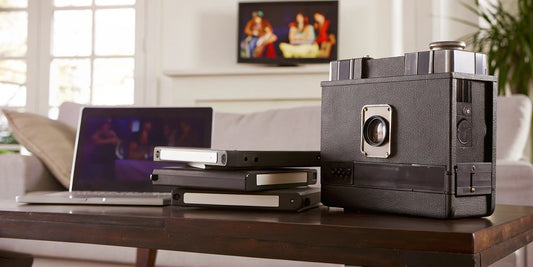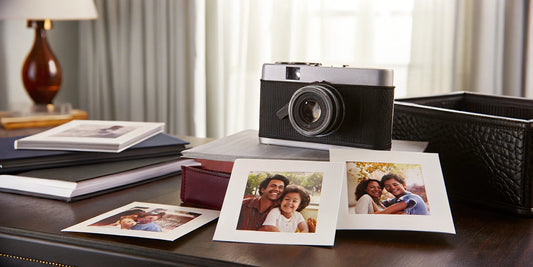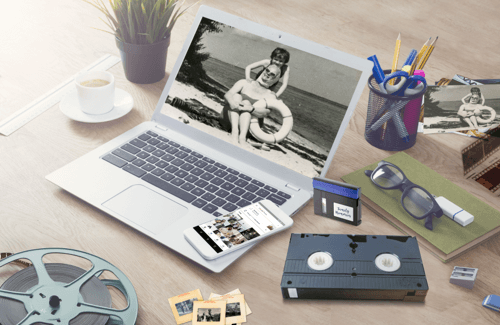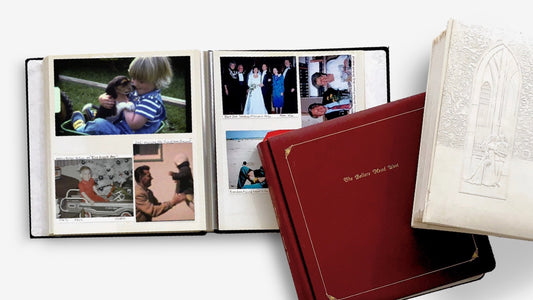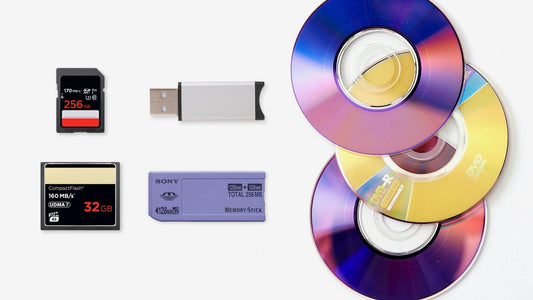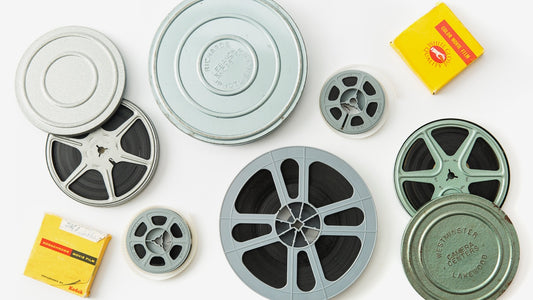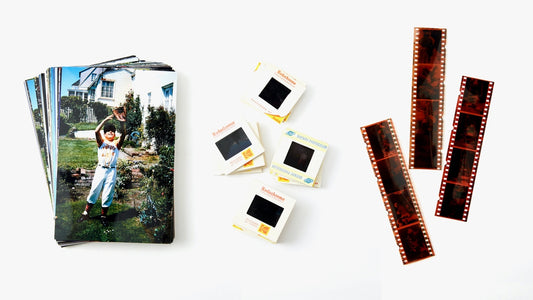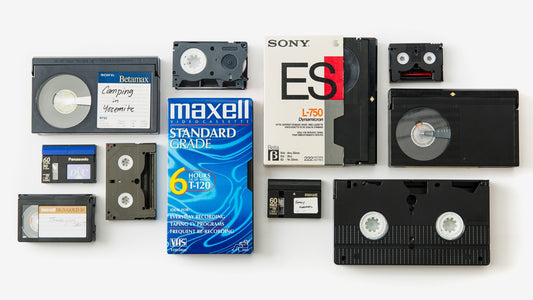Think of an MP4 file as a digital memory box. It’s not just a single video; it’s a versatile container that neatly holds all the different parts of your memory together—the moving pictures, the sound of laughter, and even extra details like subtitles or descriptive notes. This clever packaging is what makes it so powerful. When you get your home movies back from a video transfer service, you’re receiving a complete story. This guide will explain what is MP4 format by opening up this digital box to show you how it keeps your memories perfectly synchronized, easy to share, and looking great.
Key Takeaways
- Think of it as an all-in-one package: An MP4 file neatly bundles your video, audio, and even subtitles into a single, organized file, ensuring your memories play back perfectly every time.
- Get the best of both worlds with quality and size: MP4s use smart compression to keep your videos looking sharp while creating manageable file sizes that are easy to store on your computer and share with family.
- Choose a format built for the long haul: As the universal standard for video, MP4 is supported by nearly every device, making it a reliable choice for ensuring your digitized memories remain accessible for years to come.
What is an MP4 File?
If you’ve ever watched a video on your phone, computer, or TV, you’ve almost certainly used an MP4 file. Officially known as MPEG-4 Part 14, the MP4 is the go-to digital format for video today. Think of it as a universal language that nearly every modern device can understand, which is why it’s perfect for sharing and saving your precious home movies. When you use a video transfer service to digitize your old tapes, the final product is often an MP4 file, giving you a convenient and high-quality way to relive your favorite moments.
The real magic of the MP4 is its versatility. It’s what’s known as a “container format,” which means it’s like a digital box that can hold different types of media all in one neat package. While it’s mostly used for video and audio, it can also store things like subtitles and still images. This all-in-one capability, combined with its ability to deliver great quality without creating enormous files, has made it the standard for everything from streaming movies online to sharing a clip of your kid’s first steps with family. It’s the modern-day equivalent of a photo album and a home movie reel, all rolled into one accessible file.
What's a Container Format?
So, what does it really mean for a file to be a "container"? Imagine you have a memory box. Inside, you might keep old photos, a cassette tape with a recording, and maybe a written note explaining the occasion. An MP4 file works in a similar way. The file itself is the box, and inside it holds separate tracks for the video (the moving pictures) and the audio (the sound). It can also hold other data, like subtitles or chapter markers. This structure is what makes MP4s so flexible and efficient for everything from digitizing old film to watching videos on the internet.
Where Did MP4 Come From?
The MP4 format wasn't just created overnight; it was developed by the International Organization for Standardization (ISO) to be a global standard for digital video. First released in 2001, it was built on the foundation of Apple's QuickTime file format. By creating a standardized format, its creators ensured that a video file made on one device could be reliably played on another, anywhere in the world. This reliability is a huge reason why MP4 is the ideal choice for preserving your family’s legacy. It’s a stable, time-tested format you can trust to keep your memories safe for years to come.
What's Inside an MP4 File?
Think of an MP4 file as a digital memory box. It’s not just one thing; it’s a container that neatly holds all the different parts of your video together. When you send your old home movies to be digitized, they come back as these tidy MP4 files, which hold the sights, sounds, and even extra details of your precious moments. This clever packaging is what makes MP4s so versatile and easy to share with family and friends.
Inside this digital container, you'll find several distinct tracks, each with its own job. The most obvious are the video and audio tracks, but there can be more. This structure ensures that everything plays back perfectly synchronized, so the sound of your child’s laughter matches their smile on screen. Let's open up this digital box and see what’s inside.
The Video Track
The video track is the heart of your memory—it’s the moving picture itself. This is where you see the candles being blown out on a birthday cake or the first dance at a wedding. This visual information is encoded, or translated, into a language that your computer or TV can understand, most commonly H.264. This process makes the file small enough to store and share without sacrificing the crisp, clear quality you want. When you use a video transfer service, we ensure this track faithfully represents your original footage, preserving every detail for you to relive.
The Audio Track
What’s a home movie without the sound? The audio track holds all the sounds that bring your memories to life: the background music at a holiday party, the excited chatter, and the voices of loved ones. MP4 files typically use a high-quality audio format called AAC (Advanced Audio Coding) to capture this sound clearly. Because the MP4 container is so flexible, it can support various audio types, ensuring that the sound of your memories is just as rich and clear as the picture. It’s this combination of sight and sound that makes watching old videos so special.
Subtitles and Other Media
MP4 files can hold more than just the main video and audio. They also have space for extra layers of information, like subtitles. This is a wonderful feature if you want to add captions for family members who are hard of hearing or translate a conversation for relatives who speak another language. You could even add text that explains the context of a memory, like "Grandma's 80th Birthday - 1995." This capability makes your digitized memories more accessible and meaningful for everyone in the family, adding another layer of richness to the story.
Hidden Details (Metadata)
One of the most helpful parts of an MP4 file is the metadata. Think of it as the digital equivalent of writing on the back of a photograph. This "hidden" information includes details like the title, date, and even a short description of the video. When your home movies are converted through a photo transfer or video service, this metadata makes organizing your digital library a breeze. Instead of searching through generically named files, you can easily find "Christmas Morning 1992" or "Family Vacation to the Grand Canyon," ensuring your cherished moments are never lost in a cluttered folder.
How MP4 Files Work
Have you ever wondered what’s happening behind the scenes when you press play on a video? An MP4 file isn’t just one thing; it’s a cleverly organized package that holds all the different parts of your video—the picture, the sound, and more—and tells your computer or phone exactly how to play them together. It’s like a digital box for your memories, designed to be small enough to share easily while keeping the quality crystal clear. Let’s take a look at how this popular format pulls it all off.
How Compression Keeps Files Small
The magic behind MP4’s small file size is a process called compression. Think of it like vacuum-sealing your clothes for a trip—you’re removing the extra air to make everything fit into a smaller suitcase. Similarly, video compression intelligently removes redundant data from your video file to shrink its size without sacrificing much quality.
MP4 is what’s known as a container format. This means it doesn't compress the video itself, but rather holds the different media tracks (like video and audio) that have already been compressed using various methods. This makes it incredibly flexible and is a key reason why it’s so widely used for everything from streaming online to saving your precious home movies.
Syncing Video and Audio
A video file is useless if the sound doesn’t match the picture. Inside an MP4 container, the data is neatly organized into different sections, almost like digital building blocks. One block contains the metadata (the video’s instruction manual), while another holds the actual media data (the video and audio).
This structure is what allows a media player to read the instructions and perfectly synchronize the video and audio tracks. It ensures that when you see someone speaking in your family video, you hear their voice at the exact same time. This precise organization is crucial for a smooth playback experience, making sure your memories are replayed just as you remember them.
How the File is Organized
For a video to play correctly, your device needs to know some basic information first, like the video’s resolution and frame rate. In an MP4 file, this information is stored in a special section, sometimes called the "moov atom." Think of it as the file’s table of contents.
Ideally, this table of contents is located at the beginning of the file, so a media player can read it instantly and start playing the video. However, if it’s at the very end, the entire file has to be downloaded before it can begin playing. This is why digitizing your old tapes with a professional video transfer service is so important—we ensure your files are structured correctly for easy playback everywhere.
The Pros and Cons of MP4
Choosing the right format for your digitized memories is a big deal, and MP4 is a fantastic choice for so many reasons. But like anything in the tech world, it has its strengths and a few things to keep in mind. Understanding these pros and cons helps you get the most out of your precious videos, whether you're sharing a wedding clip from the 90s or watching your kid’s first steps on your TV.
The main reason MP4 is so popular is its incredible balance. It manages to keep your videos looking crisp and clear while making the file size manageable enough to easily store and share. This makes it the perfect modern home for your old memories. When you get your tapes and film reels back from a video transfer service, you want a format that’s built for today’s world. MP4 delivers on that promise, making it simple to bring your past into the present. Let’s walk through what makes it great and what you should watch out for.
Pro: Plays Almost Everywhere
One of the best things about the MP4 format is its universal compatibility. Think of it as the most popular guest at the party—it gets along with everyone. You can play an MP4 file on your iPhone, Android tablet, Windows PC, MacBook, and even your smart TV without needing special software. This makes sharing your memories with family and friends completely painless. You can upload them to social media, send them in an email, or stream them to your television without worrying if the recipient will be able to watch them. This widespread support ensures your digitized home movies are accessible and easy to enjoy for years to come.
Pro: Great Quality, Small Size
MP4 files are masters of efficiency. They use a clever compression technique that significantly shrinks the file size without sacrificing much of the visual quality. This is a huge advantage when you’re digitizing hours of home movies. Instead of ending up with massive, clunky files that eat up all your hard drive space, you get files that are easy to store, manage, and upload to the cloud. This balance is why MP4 is the standard for online streaming services and social media—it delivers a great viewing experience without the long buffering times. For your personal collection, it means you can fit more memories onto your computer or storage device.
Pro: Keeps Your Memories Looking Great
When you’re preserving something as important as your family history, quality is everything. You want those moments to look as good as you remember them. The MP4 format excels at maintaining high visual quality, even after compression. The details in your old film reels and videotapes—the smiles, the scenery, the nostalgic outfits—will remain sharp and vibrant. This means you don’t have to choose between a manageable file size and a clear picture. With MP4, you get both, ensuring your most cherished memories are preserved with the clarity and color they deserve for future generations to enjoy.
Con: Can Require a Powerful Computer
While watching MP4 files is easy on almost any device, creating or editing them can sometimes demand a bit more from your computer. High-resolution videos, like those in 4K, contain a lot of data, and processing that data can be intensive. If you plan on doing heavy video editing—like cutting clips together, adding music, or applying effects—on an older computer, you might notice it slows down or struggles to keep up. For most people who simply want to watch and share their digitized memories, this isn't an issue. But if you’re a budding filmmaker looking to rework your old footage, it’s something to be aware of.
Con: Has Some Technical Limits
MP4 uses what’s called "lossy" compression, which means that each time you edit and re-save the file, a tiny amount of data can be lost. Think of it like making a photocopy of a photocopy—each new version is just a little less sharp than the one before. For this reason, it’s always best to keep the original MP4 file you receive from your digitization service as your master copy. If you want to make edits, save a new version instead of overwriting the original. This way, you’ll always have the highest-quality version of your memory to go back to, preventing any gradual loss of detail over time.
How to Use Your MP4 Files
Once you have your newly digitized home movies, the real fun begins. An MP4 file is your ticket to editing, sharing, and reliving your favorite moments on modern devices. Whether you received your files from a video transfer service or have them on your computer, you have a versatile format that’s ready to go. But to get the most out of your digital memories, it helps to know a few basics about how to handle them. From recognizing different file types to finding the right software, here’s how you can start enjoying your MP4 videos.
Common MP4 File Names
While most of your video files will end with the .mp4 extension, you might occasionally run into variations. Think of these as close cousins in the same family, each with a slightly different purpose. Seeing a different extension doesn't mean something is wrong; it just gives you a clue about what's inside. For example, .m4a is often used for audio-only files, like songs you might have purchased online. You might also see .m4v, which Apple sometimes uses for video files in iTunes. Don't let these variations confuse you—they all stem from the same core MP4 file format and will typically play on the same devices and software without any issues.
How to Convert Other Videos to MP4
Maybe you have some old digital videos saved in a different format, like AVI or WMV, and you want to get them all organized as MP4s. Converting them is a great idea. Because MP4 files are so efficient, they often create a smaller file size without a noticeable drop in quality, which is perfect for saving space on your hard drive or sharing online. There are many free and easy-to-use tools available that can convert your videos. You simply upload your original video, select MP4 as the output format, and the software handles the rest, giving you a universally compatible file that’s ready to share.
Our Favorite Software and Tools
You don't need to be a video expert to watch, edit, or share your MP4 files. In fact, your computer likely already has everything you need. Both Windows (Media Player or the Movies & TV app) and macOS (QuickTime) have built-in players that handle MP4s perfectly. For simple edits, like trimming the start or end of a clip, Apple Photos and Microsoft Clipchamp (which is now included with Windows) are fantastic free options. If you want a do-it-all tool that can play almost any video file you throw at it, we recommend VLC Media Player. It’s a free, powerful program that works on virtually any device.
Best Ways to Use MP4
Once you have your precious memories converted into MP4 files, a world of possibilities opens up. This format is incredibly versatile, making it easy to store, share, and enjoy your videos for years to come. Here are some of the best ways to put your new digital videos to use.
Find the Best Quality Settings
MP4 files are known for balancing great quality with a manageable file size. Because the files are compressed, they don’t take up a ton of space on your computer or phone. When you’re saving your own videos, you’ll often have options to export them in different quality settings. For treasured family videos, you’ll want to choose the highest quality possible to preserve every detail. The good news is that when you use a professional service for your video transfer, we take care of all the technical details. We optimize the settings to ensure your memories look sharp and clear without creating a file that’s too bulky to manage.
Tips for Compressing Your Videos
Sometimes you might need to make a video file even smaller, especially if you want to send it in an email or a text message. This is where compression comes in handy. MP4 files are already quite efficient, but you can compress them further using various software tools. Programs like HandBrake are popular for this, but there are also simple online tools you can use for quick adjustments. Compressing a video reduces its file size, which means faster uploads and downloads. Just keep in mind that heavy compression can reduce the video quality, so it’s always a good idea to keep a copy of your original, high-quality file safely stored.
Share on Social Media and Streaming Sites
Ready to share that hilarious clip from a childhood birthday party? MP4 is the go-to format for virtually every social media and video-sharing platform, including YouTube, Facebook, Instagram, and TikTok. Its universal compatibility means you can upload your digitized home movies without worrying about whether they’ll play correctly. This makes it incredibly simple to share moments from a recent film transfer with family and friends, no matter where they are in the world. You can create a private YouTube channel for the whole family or share short clips on your favorite social feed, bringing old memories into your modern life.
Use MP4 for Video Calls
Have you ever wanted to share an old home movie during a family video call? With MP4 files, it’s easy. Because the format is so common and the files are relatively small, you can share your screen on platforms like Zoom, Google Meet, or FaceTime and play a video without frustrating lag or buffering. It’s a wonderful way to connect with loved ones who live far away. Imagine hosting a virtual movie night for a family reunion, sharing digitized videos from your parents’ wedding or your first family vacation. It’s a perfect way to relive special moments together, even when you’re miles apart.
Create Educational Videos
While you might think of educational videos as something for school or work, you can apply the same ideas to your family history. MP4 files can store more than just video and audio; they can also contain subtitles, chapter markers, and other data. You can use free video editing software to add text identifying people, places, and dates in your old home movies. Or, you could combine clips with photos from your album scanning project to create a beautiful family history documentary. Adding these details creates a richer story, preserving the context of your memories for future generations to understand and appreciate.
Why MP4 is Great for Preserving Your Memories
When you decide to digitize your family’s precious home movies, you want to be sure they’ll last for generations. Choosing the right file format is a huge part of that, and for video, MP4 is the gold standard. Think of it as the perfect digital time capsule for your memories. It strikes an ideal balance between high-quality video and a manageable file size, which is exactly what you need when you’re converting years of tapes and film reels.
The beauty of MP4 is its universal compatibility. You can play these files on almost any device you own—your phone, laptop, tablet, or smart TV—without needing special software. This means sharing that hilarious video of your toddler’s first steps or your parents’ wedding day is as simple as sending a file. When you get your memories back from a video transfer service, receiving them as MP4 files ensures they are immediately ready to watch, share, and enjoy with everyone you love, no technical headaches required.
Store Your Videos for the Long Haul
One of the biggest advantages of the MP4 format is its efficiency. MP4 files are excellent for watching and downloading videos because they are typically smaller than other video file types. This makes them perfect for both streaming and storing. For you, this means you can save your entire collection of home movies without filling up your computer’s hard drive or paying for tons of cloud storage. A smaller file size also makes it much faster to upload videos to social media or send them to family members via email, so you can share those cherished moments without the long wait.
How the Format Stays Current
Have you ever found an old file on a computer that you couldn’t open because the software was outdated? That’s a real concern when preserving digital memories. Luckily, MP4 is a versatile and widely supported video format, which makes it a safe bet for the future. Because it’s the standard for online video, nearly every new device and platform is built to play MP4s. This incredible compatibility means you can feel confident that the videos you digitize today will still be viewable on the technology of tomorrow, ensuring your memories remain accessible for years to come.
What's Next for Video Formats?
The MP4 format isn't just a passing trend; it’s built on a solid foundation that has stood the test of time. It was developed based on Apple's QuickTime File Format and is part of a broader international standard. This strong technical background is why it has become so dominant. While new video formats will always emerge, MP4’s deep roots and universal adoption mean it will remain a primary format for a very long time. Its stability gives you peace of mind that you’re choosing a reliable format for your family’s irreplaceable film transfer projects.
Plan for the Future of Your Videos
Organizing a lifetime of memories can feel like a huge task, but MP4 files have a hidden feature that makes it much easier: metadata. MP4s can store extra information, or metadata, right inside the file itself, including titles, descriptions, and dates. After you’ve digitized your tapes, you can label each file with details like "Christmas 1995" or "Sarah's 3rd Birthday." This turns a folder of generic file names into a searchable, organized library of your family’s history, making it simple to find the exact moment you’re looking for.
Related Articles
- How to Preserve DV Tapes: A Complete Guide
- How to Convert DV Tapes to Digital
- The Ultimate Guide to Digitizing Home Movies
- How to Convert MicroMV Tapes to Digital
- Video Tape to Digital: What You Need to Know
Frequently Asked Questions
Why is MP4 the best choice for my old home movies? Think of MP4 as the most reliable and universal format for your digital memories. It strikes the perfect balance by keeping your videos looking sharp and clear while ensuring the file sizes are small enough to easily store and share. This means you can send a video to your cousin without any trouble, and you can be confident it will play on their phone, computer, or TV without any special software.
Do I need to buy special software to watch these MP4 files? Not at all. The great thing about MP4 is that it’s a universal standard, so your devices already know exactly what to do with it. Your computer (both Windows and Mac), smartphone, and smart TV have built-in media players that can play MP4 files perfectly. You can start watching your digitized memories the moment you receive them, no technical setup required.
The post mentioned "lossy" compression. Does that mean my videos will get worse over time? That's a great question, and the short answer is no, your original file will not degrade. "Lossy" compression simply means that to create a manageable file size, some redundant data is removed. The key is to treat the original MP4 file you receive as your master copy. If you decide to edit it, always save your changes as a new file. This way, your original memory remains untouched and in the highest possible quality.
I have my MP4 files. What's the first thing I should do with them? Once you have your files, the most important first step is to back them up. Create at least one copy on a separate device, like an external hard drive or a cloud storage service. After they're safely backed up, take a few minutes to rename the files with descriptive titles, like "Mom's Wedding 1985" or "Family Vacation 1992." This will make it so much easier to find the exact moment you're looking for later on.
How is an MP4 different from other video files I've seen, like MOV or AVI? While formats like MOV and AVI work well, they can sometimes be picky about which devices or software will play them. MP4 is the most widely accepted format across the board. Choosing MP4 for your digitized memories is the safest bet for long-term accessibility and easy sharing. It removes the guesswork and ensures that anyone you share your videos with can watch them without a problem.


